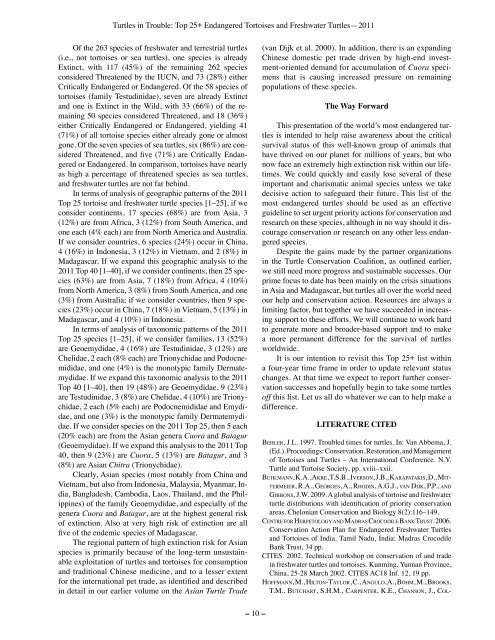Turtles in Trouble: The World's 25+ Most Endangered - Wildlife ...
Turtles in Trouble: The World's 25+ Most Endangered - Wildlife ...
Turtles in Trouble: The World's 25+ Most Endangered - Wildlife ...
- No tags were found...
Create successful ePaper yourself
Turn your PDF publications into a flip-book with our unique Google optimized e-Paper software.
<strong>Turtles</strong> <strong>in</strong> <strong>Trouble</strong>: Top <strong>25+</strong> <strong>Endangered</strong> Tortoises and Freshwater <strong>Turtles</strong>—2011Of the 263 species of freshwater and terrestrial turtles(i.e., not tortoises or sea turtles), one species is alreadyExt<strong>in</strong>ct, with 117 (45%) of the rema<strong>in</strong><strong>in</strong>g 262 speciesconsidered Threatened by the IUCN, and 73 (28%) eitherCritically <strong>Endangered</strong> or <strong>Endangered</strong>. Of the 58 species oftortoises (family Testud<strong>in</strong>idae), seven are already Ext<strong>in</strong>ctand one is Ext<strong>in</strong>ct <strong>in</strong> the Wild, with 33 (66%) of the rema<strong>in</strong><strong>in</strong>g50 species considered Threatened, and 18 (36%)either Critically <strong>Endangered</strong> or <strong>Endangered</strong>, yield<strong>in</strong>g 41(71%) of all tortoise species either already gone or almostgone. Of the seven species of sea turtles, six (86%) are consideredThreatened, and five (71%) are Critically <strong>Endangered</strong>or <strong>Endangered</strong>. In comparison, tortoises have nearlyas high a percentage of threatened species as sea turtles,and freshwater turtles are not far beh<strong>in</strong>d.In terms of analysis of geographic patterns of the 2011Top 25 tortoise and freshwater turtle species [1–25], if weconsider cont<strong>in</strong>ents, 17 species (68%) are from Asia, 3(12%) are from Africa, 3 (12%) from South America, andone each (4% each) are from North America and Australia.If we consider countries, 6 species (24%) occur <strong>in</strong> Ch<strong>in</strong>a,4 (16%) <strong>in</strong> Indonesia, 3 (12%) <strong>in</strong> Vietnam, and 2 (8%) <strong>in</strong>Madagascar. If we expand this geographic analysis to the2011 Top 40 [1–40], if we consider cont<strong>in</strong>ents, then 25 species(63%) are from Asia, 7 (18%) from Africa, 4 (10%)from North America, 3 (8%) from South America, and one(3%) from Australia; if we consider countries, then 9 species(23%) occur <strong>in</strong> Ch<strong>in</strong>a, 7 (18%) <strong>in</strong> Vietnam, 5 (13%) <strong>in</strong>Madagascar, and 4 (10%) <strong>in</strong> Indonesia.In terms of analysis of taxonomic patterns of the 2011Top 25 species [1–25], if we consider families, 13 (52%)are Geoemydidae, 4 (16%) are Testud<strong>in</strong>idae, 3 (12%) areChelidae, 2 each (8% each) are Trionychidae and Podocnemididae,and one (4%) is the monotypic family Dermatemydidae.If we expand this taxonomic analysis to the 2011Top 40 [1–40], then 19 (48%) are Geoemydidae, 9 (23%)are Testud<strong>in</strong>idae, 3 (8%) are Chelidae, 4 (10%) are Trionychidae,2 each (5% each) are Podocnemididae and Emydidae,and one (3%) is the monotypic family Dermatemydidae.If we consider species on the 2011 Top 25, then 5 each(20% each) are from the Asian genera Cuora and Batagur(Geoemydidae). If we expand this analysis to the 2011 Top40, then 9 (23%) are Cuora, 5 (13%) are Batagur, and 3(8%) are Asian Chitra (Trionychidae).Clearly, Asian species (most notably from Ch<strong>in</strong>a andVietnam, but also from Indonesia, Malaysia, Myanmar, India,Bangladesh, Cambodia, Laos, Thailand, and the Philipp<strong>in</strong>es)of the family Geoemydidae, and especially of thegenera Cuora and Batagur, are at the highest general riskof ext<strong>in</strong>ction. Also at very high risk of ext<strong>in</strong>ction are allfive of the endemic species of Madagascar.<strong>The</strong> regional pattern of high ext<strong>in</strong>ction risk for Asianspecies is primarily because of the long-term unsusta<strong>in</strong>ableexploitation of turtles and tortoises for consumptionand traditional Ch<strong>in</strong>ese medic<strong>in</strong>e, and to a lesser extentfor the <strong>in</strong>ternational pet trade, as identified and described<strong>in</strong> detail <strong>in</strong> our earlier volume on the Asian Turtle Trade(van Dijk et al. 2000). In addition, there is an expand<strong>in</strong>gCh<strong>in</strong>ese domestic pet trade driven by high-end <strong>in</strong>vestment-orienteddemand for accumulation of Cuora specimensthat is caus<strong>in</strong>g <strong>in</strong>creased pressure on rema<strong>in</strong><strong>in</strong>gpopulations of these species.<strong>The</strong> Way ForwardThis presentation of the world’s most endangered turtlesis <strong>in</strong>tended to help raise awareness about the criticalsurvival status of this well-known group of animals thathave thrived on our planet for millions of years, but whonow face an extremely high ext<strong>in</strong>ction risk with<strong>in</strong> our lifetimes.We could quickly and easily lose several of theseimportant and charismatic animal species unless we takedecisive action to safeguard their future. This list of themost endangered turtles should be used as an effectiveguidel<strong>in</strong>e to set urgent priority actions for conservation andresearch on these species, although <strong>in</strong> no way should it discourageconservation or research on any other less endangeredspecies.Despite the ga<strong>in</strong>s made by the partner organizations<strong>in</strong> the Turtle Conservation Coalition, as outl<strong>in</strong>ed earlier,we still need more progress and susta<strong>in</strong>able successes. Ourprime focus to date has been ma<strong>in</strong>ly on the crisis situations<strong>in</strong> Asia and Madagascar, but turtles all over the world needour help and conservation action. Resources are always alimit<strong>in</strong>g factor, but together we have succeeded <strong>in</strong> <strong>in</strong>creas<strong>in</strong>gsupport to these efforts. We will cont<strong>in</strong>ue to work hardto generate more and broader-based support and to makea more permanent difference for the survival of turtlesworldwide.It is our <strong>in</strong>tention to revisit this Top <strong>25+</strong> list with<strong>in</strong>a four-year time frame <strong>in</strong> order to update relevant statuschanges. At that time we expect to report further conservationsuccesses and hopefully beg<strong>in</strong> to take some turtlesoff this list. Let us all do whatever we can to help make adifference.LITERATURE CITEDBEHLER, J.L. 1997. <strong>Trouble</strong>d times for turtles. In: Van Abbema, J.(Ed.). Proceed<strong>in</strong>gs: Conservation, Restoration, and Managementof Tortoises and <strong>Turtles</strong> – An International Conference. N.Y.Turtle and Tortoise Society, pp. xviii–xxii.BUHLMANN, K.A., AKRE, T.S.B., IVERSON, J.B., KARAPATAKIS, D., MIT-TERMEIER, R.A., GEORGES, A., RHODIN, A.G.J., VAN DIJK, P.P., ANDGIBBONS, J.W. 2009. A global analysis of tortoise and freshwaterturtle distributions with identification of priority conservationareas. Chelonian Conservation and Biology 8(2):116–149.CENTRE FOR HERPETOLOGY AND MADRAS CROCODILE BANK TRUST. 2006.Conservation Action Plan for <strong>Endangered</strong> Freshwater <strong>Turtles</strong>and Tortoises of India. Tamil Nadu, India: Madras CrocodileBank Trust, 34 pp.CITES. 2002. Technical workshop on conservation of and trade<strong>in</strong> freshwater turtles and tortoises. Kunm<strong>in</strong>g, Yunnan Prov<strong>in</strong>ce,Ch<strong>in</strong>a, 25-28 March 2002. CITES AC18 Inf. 12, 19 pp.HOFFMANN, M., HILTON-TAYLOR, C., ANGULO, A., BÖHM, M., BROOKS,T.M., BUTCHART, S.H.M., CARPENTER, K.E., CHANSON, J., COL-– 10 –







![RaLand / SeaScape [PDF] - Wildlife Conservation Society](https://img.yumpu.com/49974326/1/190x245/raland-seascape-pdf-wildlife-conservation-society.jpg?quality=85)








